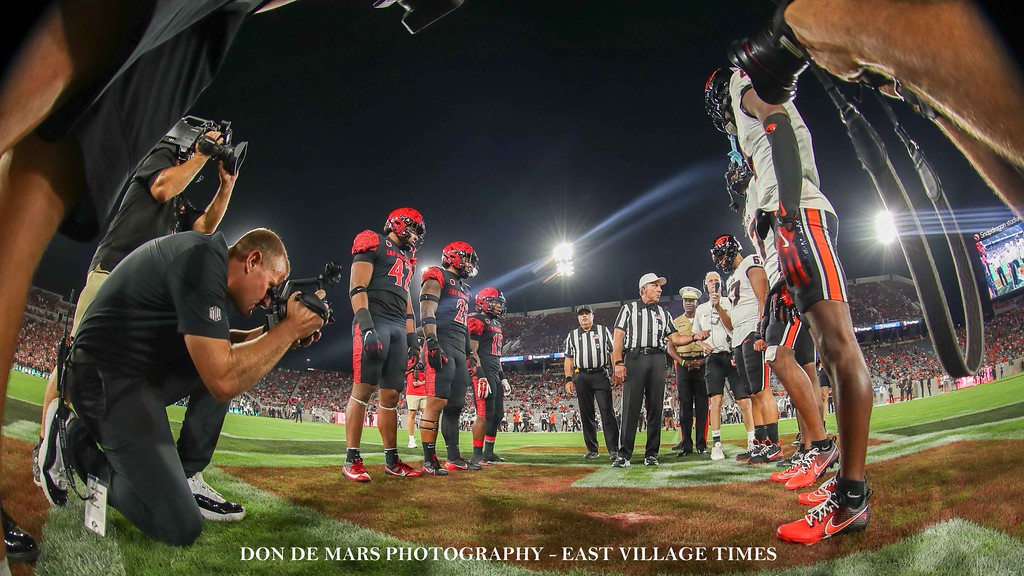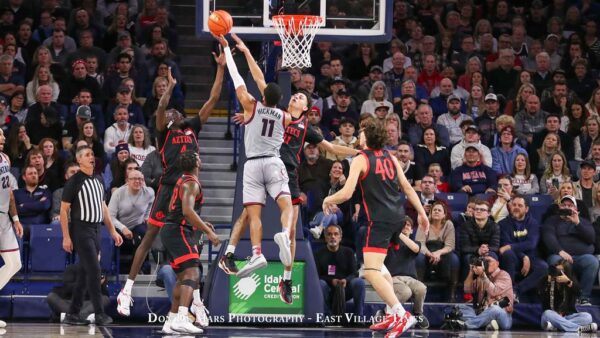Three tiers separate Pac-12’s options for future members

Coin Flip before SDSU and Oregon State. (Don De Mars/EVT)

San Diego State and the Pac-12 announced a partnership that will begin on July 1, 2026. The Aztecs will join what is being dubbed the new era of the Pac-12.
On Thursday, Athletic Director JD Wicker offered insights into the decision. He also gave thoughts on the shape of the new conference.
“You need to be at a minimum of nine football-playing schools, so you have eight conference games,” Wicker explained. “I’d like one or two more potentially, as you look at basketball scheduling and wanting to probably be at 18 conference games. We’re going to go out, and we’re going to find the best schools, and if that ends up being a larger number or just eight, we’ll figure it out.”
The conversation on what additions the Pac-12 should make has centered on adding two so it can reach the NCAA minimum threshold to be considered a conference. While Wicker left open the possibility of that lowest total, his comments suggest bringing in four schools is more likely.
Gonzaga would be an ideal non-football addition. For all the hand-wringing about the Mountain West’s new 20-game schedule, it was interesting that Wicker said an 18-game conference schedule would be his choice for basketball.
Aside from the Zags, other schools that should interest the Pac-12 as basketball-only additions include Long Beach State, UC Riverside, and UC San Diego. The latter schools already have athletic budgets around $25 million. According to USA Today, this amount is at the level spent by lower-budgeted FBS schools.
UCSD has been an invaluable partner with SDSU’s pursuit of doctoral programs. Could the partnership spill over to conference affiliation?
The Tritons’ current gym is too small. The newly opened Frontwave Arena in Oceanside is home to the Clippers G-League team and is half an hour from campus. It would take an additional annual athletic budget investment of $10-20 million to make UCSD a viable option.
With two years to go before the New Era Pac-12 kicks off, there is time to see how things play out before deciding. Assuming the Pac-12 succeeds in adding a non-football school, assessing the possibilities of who the other three schools could be comes down to three tiers.

Tier I: Former Pac-12 Members
The only specific schools Wicker mentioned outside of the Pac-12 were Cal and Stanford. Like Oregon State, Washington State, and SDSU, the Golden Bears and Cardinal were left at the altar when Oregon and Washington left for the Big Ten.
Instead of staying behind to work on rebuilding the Pac-12, they bolted for the ACC. They accepted reduced revenue sharing for a spot in the ACC. For the first seven years, the duo will receive 30% of what their conference partners receive. In year eight, that jumps to 70% and 75% in year nine before becoming a full member in a decade.
“Look at Cal and Stanford right now and what they’re getting from the ACC versus what everybody else is getting and how that is going to impact their ability from a competitive standpoint,” Wicker said.
Could SDSU’s AD’s public comments be interpreted as a sales pitch to the California-based schools? Wicker also explained how most P4 schools do not have a valid pathway to the playoff.
Wicker said he assumes the new Pac-12 will be part of the Group of Six fighting for one spot each season. That opportunity for success is better than anything Cal and Stanford can hope for because their ACC counterparts will each receive about $250 million more media revenue before the footing becomes equal. The Golden Bears and Cardinal will not be able to compete with the teams in their league, thus having less access to the playoff.
Not only would the former Pac-12 members have a more straightforward path to national prominence in the New Era Pac-12, but they likely would make more money. A 30% share from ACC amounts to a little over $13 million. A Pac-12 media deal with Cal and Stanford’s reputation could beat that number. Even if it fell short, the reduced cost of the travel and the quality of life improvement for its student-athletes would be worth the cost.
College football’s landscape is still in flux. It is impossible to know the best course of action on the Pac-12 should take. Chief among the considerations is what takes place with the money-making schools in the Atlantic Coast Conference.
Clemson, Florida State, and North Carolina breaking free from their ACC contract could set off another round of conference realignment. Would ESPN continue to pay the conference $30 million per team without the entity’s cream-of-the-crop schools?
Cal and Stanford would be impacted if the ACC’s marquee teams break free from the conference. Would the created chaos lead to no alternative for the schools but to return to the Pac-12? Or would the ACC increase the school’s payouts significantly to prevent the conference from breaking apart?

Tier II: American Athletic Conference Schools
Wicker would not speculate on the speed of adding new teams to the conference. He only said that SDSU’s move to the Pac-12 positioned it for short and long-term success. Earning a spot in the postseason is the ultimate goal for the program across its various teams.
If the Pac-12 can carve out a place as the best Group of Six conference, it will have an automatic bid to the college football playoff in practice, even if technically it is not an AQ conference. The best method for accomplishing that is to take the top teams from the AAC to form a G6 super conference.
From an athletic budget perspective, Memphis and South Florida would be the top selections from the AAC, with budgets over $60 million. Among the ways the Pac-12 is being pitched is as a conference that puts its students before finances. Would the distance needed to travel to Tennessee and Florida preclude the Pac-12 from offering the Tigers and Bulls?
North Texas, Tulane, Rice, UTSA, and Tulsa would also be attractive AAC schools. They have budgets between $43-50 million and play in the most football-centric part of the country.
Tulane’s recent football success and its location in the city of New Orleans could raise its profile. Rice in Houston, UTSA in San Antonio, and North Texas outside of Dallas would give the Pac-12 a coveted foothold in Texas. Academically, Tulsa is the best school in Oklahoma and fits the educational and athletic profile of the new Pac-12.
A complication to attracting AAC schools is its bylaws that require 27 months’ notice to leave. This would be too late to play in the 2026 football season. The AAC negotiated a higher exit fee with Houston, Cincinnati, and Central Florida to allow them to join the Big XII a year early. Would they be willing to do the same with the Pac-12? Could the Pac-12 get an extension from the NCAA on the eight-team requirement?
“I’ve said from the beginning that back in August [2023], as we were talking internally in the Mountain West, if we have the opportunity to take the Pac-12 brand, whether it’s a reverse merger, or if it’s schools leaving, the Pac-12 brand is so incredibly valuable, because anyone across the country when you say Pac-12, they’re like ‘Oh, the Pac-12,’ Wicker explained. “It may not be your mom and dad’s Pac-12, but what conference is your mom and dad’s conference at this point? That branding element was definitely very important.”

Tier III: Mountain West Schools
If the above options do not pan out, there are numerous possibilities in SDSU’s current conference, but it is challenging to find any obvious selections. UNLV is an option, but its location presents issues.
Las Vegas is the best place to schedule neutral events. It is also home to a growing number of professional teams that limit UNLV’s traction in its hometown.
Air Force has a P4 athletic budget and a good football program, but would two teams from Colorado make sense? New Mexico is the premier university in its state, but the Lobos football program has never recovered from forcing Rocky Long out as head coach.
Wyoming is next in line, but its distance from the rest of the schools makes it problematic. SDSU head men’s basketball coach Brian Dutcher will not get a vote but won’t miss his club’s trips to Laramie.
Nevada, San Jose State, Utah State, and Hawaii are less attractive options. An interesting scenario is what happens if the Pac-12 cannot secure any teams in the upper tiers. Would the conference pivot to adding six more MWC teams to dissolve it and avoid paying any exit fees?
Prediction
Unless they have no alternative, Cal and Stanford will not rejoin the Pac-12. Even if it is in the interest of its students, returning will make the decision-makers in those schools look bad. That will keep them married to the ACC unless the conference implodes.
One or more non-football program will be added to the Pac-12, leaving the conference three shy of nine football members. North Texas, Rice, and UTSA have the least history with the AAC. The Pac-12 will establish itself in Texas’ three largest cities and strike a blow to the next best G6 conference.
“There’s always going to be naysayers,” Wicker said when asked about the criticism that the New Era Pac-12 is just a reformed Mountain West. “There’s always going to be people whose glass is half empty, and that’s how they deal with it. You can choose to wake up and be angry about something, or you can choose to wake up and look at the best of something.”
“Obviously, what (the Pac-12) was August 4, 2023, is different than it is today, but that doesn’t mean that we’re not going to go out and we’re going to bust our tail to make it the best thing that it possibly can be and keep moving up.”
Ultimately, the importance of SDSU’s decision will not be known until conference realignment stops. That might not happen for a decade. What the Aztecs have done is position themselves as best as they can to excel whatever is down the road.
My earliest sport’s memory involve tailgating at the Murph, running down the circular exit ramps, and seeing the Padres, Chargers and Aztecs play. As a second generation Aztec, I am passionate about all things SDSU. Other interests include raising my four children, being a great husband and teaching high school.
This entire PAC 12 situation is failing to recognize that football is a dying sport. Attempting to aggregate school with the biggest dollars instead of what’s best for the student body and athletes will eventually be a disaster. One of the best schoosl to add to your list should be UCSB for soccer, Baseball and basketball yet they are omitted.
Have to give Bob credit for a unique take! UCSB on nobody’s radar , unfortunately BB & soccer are non-revenue sports and outside of a cool campus UCSB brings nothing to the table. Apparently the TV execs also fail to recognize FB as a dying sport because that’s what they are paying for. FB is the only sport that can pay for itself and everything else.